
One lens, one focal length: Simplicity and austerity are characteristic features of the Leica M system. But two Leica Tri-Elmar lenses are different, with 16/18/21 millimetres and 28/35/50 millimetres, respectively. Let’s look at them and two other varifocal lenses Leica never launched.
Some time ago, an auction reminded us that the community was about to be bestowed with a revolutionary lens. It was designed as a zoom with multiple focal lengths. And the auction brought to mind two exotic lens designs that actually made it to the market. The 28-75/3.4-5.6 Vario-Elmar-M was allegedly built in only three prototypes, and it fetched an incredible sum at the Leitz Auction No. 37: almost a quarter of a million Euros!
Moments of breathless amazement
Well, even if you are quite familiar with the Leica M world, you can have moments of breathless astonishment. When you see the perfect picture, and you take the camera to your eye. Or when you don’t because you just happen to be without a camera. When you go through your files or your prints and discover that a picture has something special you had previously overlooked, all this has some magic.
One of only three lenses and an incredible price tag
Some of us certainly feel a shiver down our spine when we browse auction results out of pure curiosity. And then, something electrifies you. This is what happened to me when I noticed two things. That Leica actually brought a zoom lens for the M system to a state of possible production. And that one of the allegedly three existing prototypes one sold for the bargain price of €240,000. This is eight times the starting price and three times the estimate. It’s a sum that only very, very, very few people can spend at all on anything. Let alone a lens.
Leica Tri-Elmar: Some general thoughts
In 2016, there was little chatter about the Vario-Elmar
The lens already showed up in a forum as early as 2016. Then a Leica beta tester leaked its existence with hardly disguised pride, but the featured VARIO-ELMAR-M 1:3.5-5.6/28-75 ASPH did not raise much interest in the readers’ comments section or by ways of backlinks to other forums (https://www.dpreview.com/forums/thread/4052244#forum-post-58320077).
Maybe, the slow f/5.6 aperture at the long end seemed unattractive to the bokeh fans. Or the idea of a continuous zoom mechanism did not convince because it requires live view. And at that time, only the not-yet-released M10 was to be the first M body with an acceptable EVF performance. Or even then, did many people doubt whether the lens would ever make it to serial production? We now know that was a reasonable view.
Two Leica Tri-Elmar lenses with multiple focal lengths were actually built
However, the spectacular auction result of the Vario-Elmar (I will not further elaborate on this lens because I do not like writing about things I do not really know) casts an interesting light on two somewhat similar lenses that Leica produced or still offers. They are the Leica MATE (medium-angle Tri-Elmar) and WATE (wide-angle Tri-Elmar), two acronyms that have become quite famous now.
One of these zoom-like lenses is the current Tri-Elmar-M 1:4/16-18-21 ASPH, which was introduced in 2006 and has remained unchanged since then. Some Leica fans call it the WATE (wide-angle Tri-Elmar). The other is the Tri-Elmar-M 1:4/28-35-50 ASPH, which has been in production only from 1998 until 2007 and has seen no fewer than three iterations in this short time. It is frequently referred to as MATE (medium-angle Tri-Elmar). Occasionally, there have been rumours that the MATE might get a successor, although the above-mentioned Vario-Elmar was not to fill this role after all.
Leica Tri-Elmar lenses: Mechanics and handling
These are stunning examples of precision engineering
I have had the opportunity to work with both the Leica MATE and WATE. So, I will share some thoughts about these lenses here. What they have in common is excellent manufacturing quality. The handling of both Leica Tri-Elmar lenses is impressive. A special feature of the MATE is the sophisticated mechanics that bring up the 28, 35, and 50-mm frame lines depending on the selected focal length. The WATE lacks this feature, and quite obviously so, as there are no M Leicas with 21, 18 or 16 frame lines. You need a live view or an external viewfinder for framing, whereas shooting with the MATE is a seamless experience. In any event, the Leica MATE and WATE are very remarkable lenses.
The MATE Tri-Elmar: Attach a viewfinder and start taking pictures
The MATE is a joy to use, and you will get used to the 50-mm position unconventionally sitting in the middle very quickly. This is not a classical zoom lens, after all. I see it as a universal rangefinder lens with the standard 50-mm focal length in the central position and one moderate extension (35) of the angle of view to one side and a prominent extension (28) to the other.
The MATE works very well with all 0.72 viewfinders
With this in mind, using the MATE is very intuitive. Framing and focusing can be done simultaneously with setting the exposure on almost all newer M bodies. The M4-P and the M-A are the only M bodies with 28-mm frame lines but no built-in meter. M3, M2 and M4 bodies offer neither metering nor 28-mm frame lines. The same applies to M bodies with 0.85 viewfinder magnification (M6, M7, MP). The use of the MATE makes hardly sense on these cameras. Everything is fine on the M9, M240 and its siblings, the M10 family, and the M11. With one exception, the lens obstructs the viewfinder to a dramatic (28) or lesser (50) extent in all positions. The beautiful, vented hood makes it even slightly worse.
Three versions: One with a E55 filter mount, two with E49
By the way – if you consider getting a MATE, keep in mind that there are three versions. The first one takes E55 filters and has a different hood (same as 24/2.8 ASPH.). The two later ones (E49) saw a mechanical redesign according to various sources such as the Leica Forum. So, the later, the better, I think. However, I heard that spare hoods for the last version are difficult to find. You are better looking out for a lens that comes with its fitting hood right away.
For the WATE Tri-Elmar, you need an external viewfinder or a live-view display
The WATE has the same excellent haptics, but the overall ergonomics are not on par with the MATE. For film-camera use, you need do need an external viewfinder. The massive Universal Wide-Angle Viewfinder (some call it Frankenfinder with a nod to Mary Shelley) was frequently sold together with the WATE.
This so-called Universal-Weitwinkelsucher M might look like a monster, but it is an amazing piece of engineering for sure. It offers five focal lengths (16, 18, 21, 24, 28 mm) and different distances to select to correct the parallax. There is even a built-in spirit level to help you get your horizon or whatever straight. You must not forget to check that the chosen focal lengths on the lens and viewfinder are in accordance.
You can focus the Leica Tri-Elmar WATE with the rangefinder
Distance and exposure settings are done with the camera’s viewfinder in the usual way. If you need a filter — for example, in black and white photography — you need an accessory ring for your WATE to adapt E67 filters. And you must ensure that no stray light from behind falls in, causing flare. More on this below. The filter holder, Leica #14473, is vented for use with external optical viewfinders.
Concluding the mechanics and handling section, I have to say that both the Leica MATE and WATE lenses are stunning pieces of technology. If you have the opportunity, give them a try and be it only for their haptics.
The optics of the Leica Tri-Elmar MATE: A beautiful lens showing its age
The late Erwin Puts tested the MATE against many contemporary and older M lenses and concluded that this tri-focal lens was better than all older 28, 35, and 50-mm lenses and more or less on the same level with the latest Leica primes. I have no reason to doubt his statement generally, but now in 2022, the evolution of lens designs is several steps ahead. First, look at sharpness and micro contrast: Even if you leave aside the ultra-high performing 35 and 50 Apo-Summicrons, I am convinced that the current 28 Summicron and Elmarit lenses outperform the MATE. And I think the 35 Summarit beats the MATE, too. I worked with both lenses but made no direct one-to-one comparison.
For this lens, 6-bit coding makes a lot of sense
The MATE I used over a longer period had no 6-bit coding, and I did not always select a profile manually. On this basis, it appears to be a bit unfair to discuss vignetting and colour drift (for details on this and for many other reasons, I thoroughly recommend a subscription to Sean Reid’s excellent website). Well, without electronic correction applied to these two phenomena, the MATE shows significant vignetting, most notably in the 35 mm position, something which surprised me.



The issues are solved with the correction profile selected manually, but this is a very clumsy workflow. You have to change the profile every time you select a new focal length (and this is what the Tri-Elmar is all about). So try to get a coded copy of the lens or have it coded (which I have done finally). In this case, the information concerning the focal length is automatically used for the correction profile (ingenious!).
A few worries about stray light
The MATE is good in flare control and reliability in difficult lighting situations — but not excellent. I repeatedly managed to push it to the limits, even with consistent use of the lens hood. However, the fact that the front lens sits quite deeply recessed in the barrel at least helps to avoid unwanted reflections. I once heard that the latest version of the MATE (the one I happened to use) is the best when it comes to flare control.







Leica Tri-Elmar MATE conclusion: Nice to have, nice to use
All in all, the MATE is extraordinarily comfortable to use and capable of producing very good images. We all know that gear plays a lesser role in the result than the industry keeps telling us. In the case of the MATE, other lenses might pair as well with your camera and produce as good a result. So, a major reason for owning this lens is certainly its very special position in the Leica M lenses genealogy. It’s just nice to own a milestone product.
The optics of the Leica Tri-Elmar WATE: Beautiful rendering with some compromise
Images taken with the WATE look great (technically, all the rest is up to you, and composing with an ultra-wide angle lens is not a trivial matter). Sharpness is good from wide open at all focal lengths with some fall-off towards the corners in a full-frame setup. The positive impression of sharpness is mainly thanks to very good micro contrast: Images shot with the WATE have a certain pop which is very pleasing.
Zoom vs prime: There is a difference
When it comes to pixel-peeping, however, you will see that resolution is not always on par with the best Leica primes. For example, the 21/3.4 Super-Elmar is far better than the wide-open WATE. Stopped down, the difference is less obvious. So, if designing a lens with a variable focal length is more of a compromise than conceiving a prime, the WATE is proof of that. Yet it remains a lens that performs up to Leica standards hands down, and there is no sensible reason to rule out the WATE because of sharpness or definition issues.
With a little help from my… algorithms
All WATEs ever produced are 6-bit coded. This is no surprise, as this lens was introduced together with the M8 back in 2006. On its sensor, the WATE makes a roughly 21/24/28 millimetre lens. It is really telling that Leica spared no expense and effort and set up this lens as a fully capable full-frame lens right away. They certainly had a full-frame sensor in mind, not only for their film camera users. How practical that they provided the much revered 90-degree angle of view (in full frame terms, 21 mm focal length) to both target groups.



The correction profile works very well. The only drawback is that you must not forget to select the profile for the individual focal length manually. I settled for the 18-mm profile as a compromise, and the results are satisfying. When the WATE is used with lens detection turned off, you see a degree of vignetting and colour drift. Used on film, both effects are heavily diminished because film is less tricky when rays of light arrive at a steep angle.
No worries about backlighting or light sources that are difficult to control
The wider your angle of view, the bigger the risk of getting the sun into your frame or, which is often worse, some light rays from reflecting objects or scattered light sources. Excellent flare control is crucial in wide-angle lenses and even more so because additional lens hoods are limited in their effect just because of geometrical laws.
Attaching a filter to the WATE is somewhat risky
Speaking of the hood, I think the WATE was the first Leica M lens to be equipped with the now-standard screw-on lens hood. The patented thread ensures that it will always be attached in the correct position. Well done, Leica. The optional filter (E 67) adapter ring works similarly. This adapter is vented to ensure the functionality of the optical rangefinder; remember the lens is fully rangefinder coupled. The disadvantage of this is that light can hit the filter from behind, which even the best lens can hardly cope with. If not needed for focusing (because you are using live view or working with the hyperfocal method), cut a precise ring from black cardboard or thin plastic and put it on the inside of the adapter. It might save you much hassle.







Leica Tri-Elmar WATE conclusion: A great piece of tech and a serious extension of your creative possibilities
In conclusion, the WATE is an excellent piece of mechanical and optical engineering and a very useful addition for those M users who want to go really wide. Partly thanks to electronic aid, the image quality is very good and can be excellent when stopped down. It is your only option when you want a genuine Leica lens as short as 16 millimetres, but you will not miss alternatives.
This lens is as good as it gets, and only a question of a photographer’s funds, needs and interests will determine whether or not they buy this lens. If you do opt for it, the WATE will considerably increase your creative possibilities and challenge you if you are more or less new to ultra-wide angle photography.
MATE and WATE: Are the Leica Tri-Elmar lenses sensible choices?
Honestly, there is very limited need to have a 28 and a 35 at one given time
The MATE is a great option if you take photos in places where changing a lens is not advisable or possible, such as sandy or dusty environments or on the stormy seaside. On the other hand, I am convinced that nobody needs a 28 and a 35 and 50 at one given time. 50 and 28 will do, or a 35 alone. But, hey, the additional option does no harm, either. More of a problem is the slow maximum aperture. You will need a camera with excellent low-light abilities for interior shooting.
Two primes are not much heavier
And if weight matters: The MATE tips the scale at 382g (weighed by me, with both caps and hood), whereas the very nice combo of 28/2.8 Elmarit ASPH and 50/2.4 Summarit amounts to a very similar 414g. Add another modest 40 grams, and you can pack a wonderful 50 Summicron instead of the (I repeat myself, underrated) Summarit into your bag. You win between one and two aperture stops. And the two-lens kit may not cost you more than the very sought-after MATE.
The WATE is great, but probably an 18 or a 21 alone will also do
The WATE is the only option if you want to shoot 16 millimetres and insist on using a Leica lens. Voigtländer has a newly improved 15-mm and a crazy 10-mm super-wide lens in its line-up). The focal range between 16 and 21 is wider than you might expect. But if you are not a passionate ultra-wide-angle shooter, you might not need all three options.
A dream partner for the Pixii?
For APS-C sensors such as the one in the Pixii with its 1.5 crop factor: Here, the 24-27-32 equivalent makes sense, however not just as much as it was in the case for the APS-H 1.33-cropped M8 back in its day. On this one, the WATE turns into a 21-24-28. You don’t even need the Frankenfinder and can use the much smaller, now discontinued, 21-24-28 viewfinder instead. I will try the combination of the WATE lens and Pixii camera in my upcoming Pixii review.
What about an 18 or 21 prime instead?
A fixed 18 or 21 with one of the slim and beautiful fixed-length external viewfinders (if needed) might be easier to use. Zeiss had the 18/4 in the line-up I reviewed in part 11 of our big series, The M Files. Unfortunately, it is no longer available new. Leica’s Super-Elmar M 18/3.8 was also discontinued, to my surprise, some time ago. I cannot praise enough the still available small, super-sharp and relatively affordable Super-Elmar-M 21/3.4.
The Leica Tri-Elmar MATE and WATE lenses: simply practical
To sum up — the Tri-Elmars might be a bit exotic, but these are lenses with a high value in actual use. Of course, you can pretty much substitute them with primes, but it is indisputable that the Tri-Elmars give you an extra dose of flexibility and allow for a speedy workflow. And they are both just engineering marvels (it is said that the MATE production was stopped simply because manufacturing costs were too high).
Certainly, these lenses, the Leica Tri-Elmar MATE and WATE are both worthy of being held in honour by Leica enthusiasts. I can well imagine that both of these varifocal lenses will become modern classics and sought-after pieces for many collections. The prices of the MATE have already risen, whereas the supply of the WATE seems to be good at the moment. If it should be discontinued one day, effects on the second-hand market are likely.
A Bi-Elmar 21/35… that would have been a scoop
I appreciate both of these exotic lenses and loved working with the Leica MATE and WATE. But I do look with a little bit of sadness to Wetzlar because Leica never had the courage to bring a Bi-Elmar 21-35 with a circa f/3.5 maximum aperture to the market. This would have met all of my (and many others’) needs as a piece of travel equipment, probably together with a smallish 90.
Konica offered exactly such an M-mount lens in the 2000s, but not many were manufactured, and they are now hard to find. Read more about it in part 13 of the Macfilos series, The M Files. But one never knows; maybe Leica will surprise us once again. If it’s up to me, I’d like this surprise to be a normal lens. Not one of which where only a few prototypes are built and which fetch absurd prices at auctions a few years later, but a mass-produced, general-audience, practical lens for rangefinder photography. Exactly as they did with the Leica WATE and MATE back 1998 and 2006.
What do you think? Are you an active user of one of the Tri-Elmar lenses? Did you use one of them in the past and give it up? Does a zoom-like lens fit into the philosophy of the Leica M system? Betrayal or achievement, then? Or are they represent a useless dead end in rangefinder lens design? Discuss here!
Want to contribute an article to Macfilos? It’s easy. Just click the “Write for Us” button. We’ll help with the writing and guide you through the process.




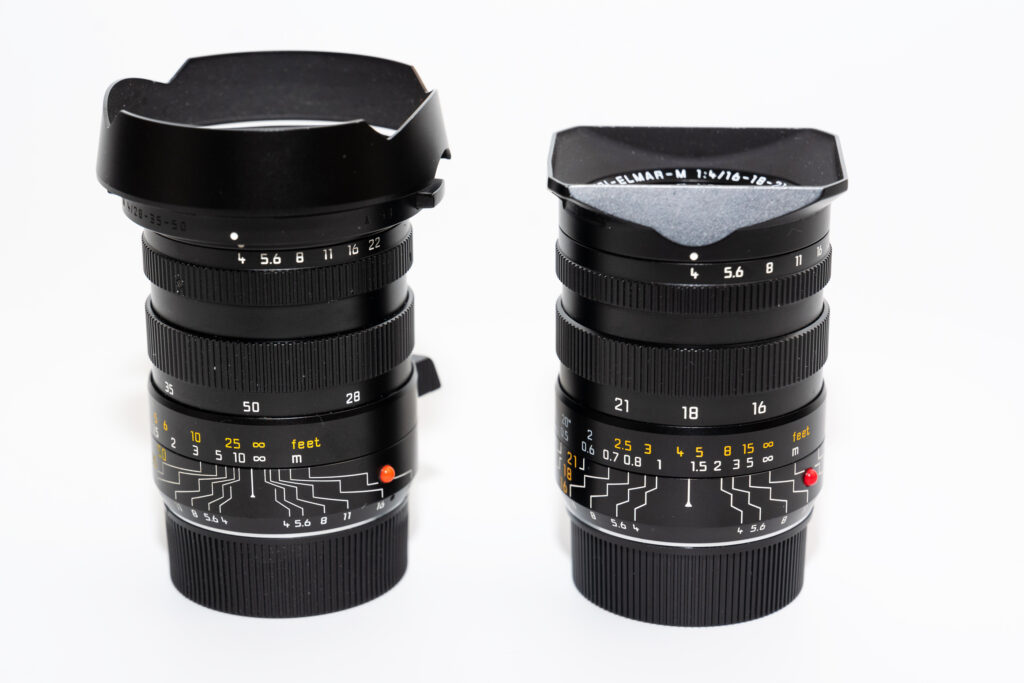
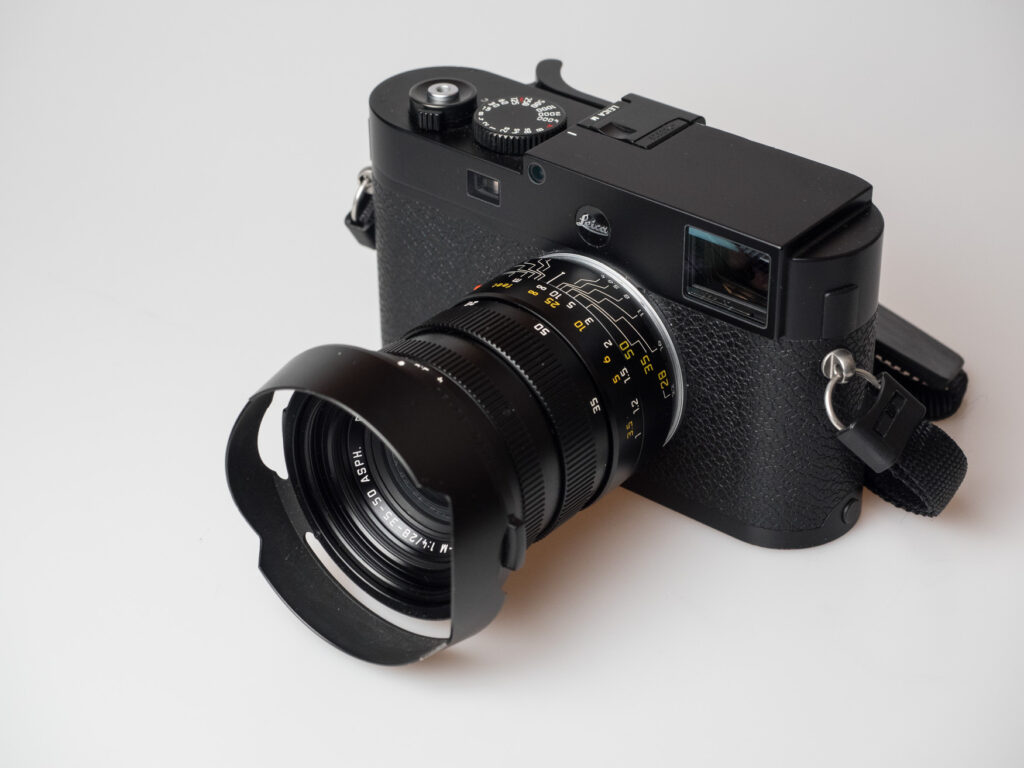
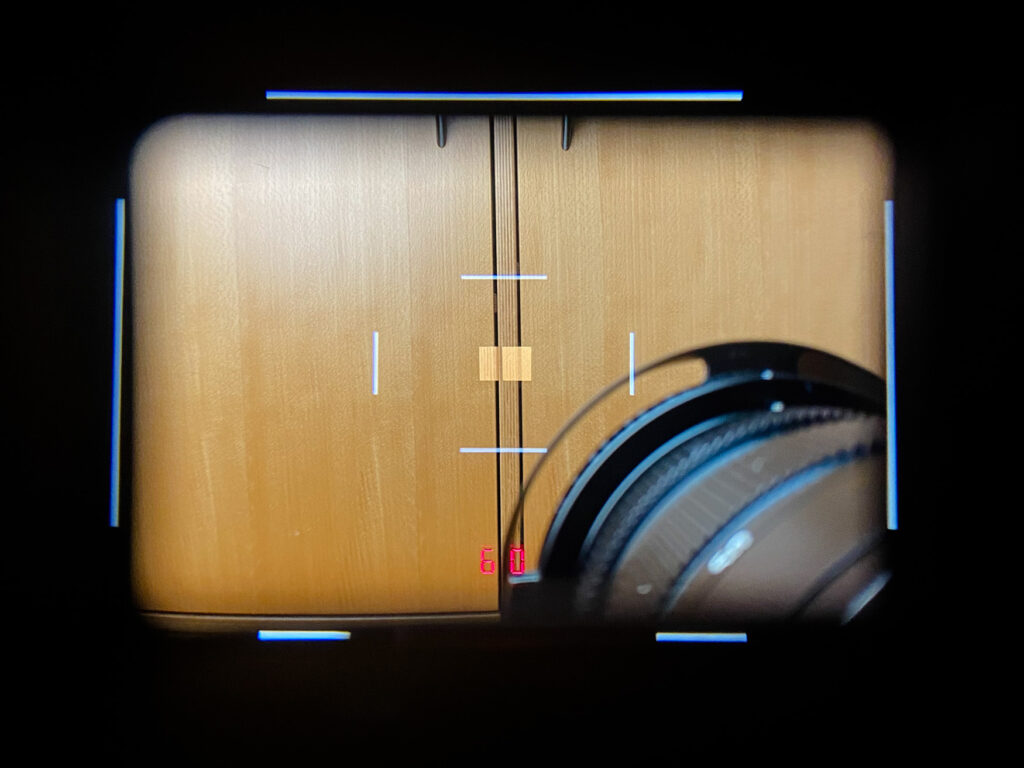
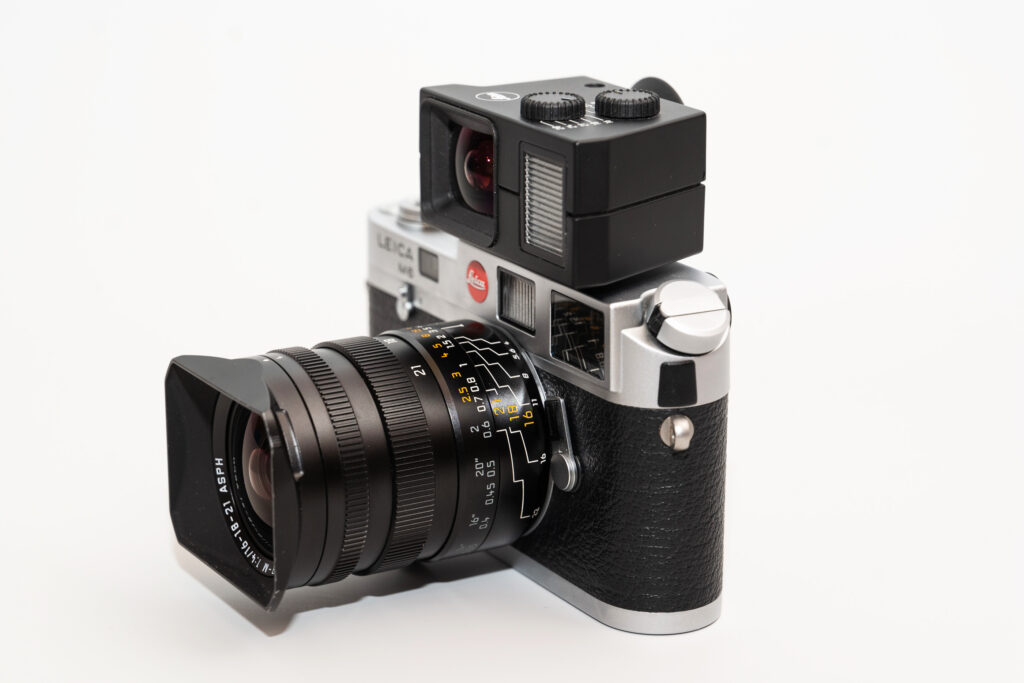
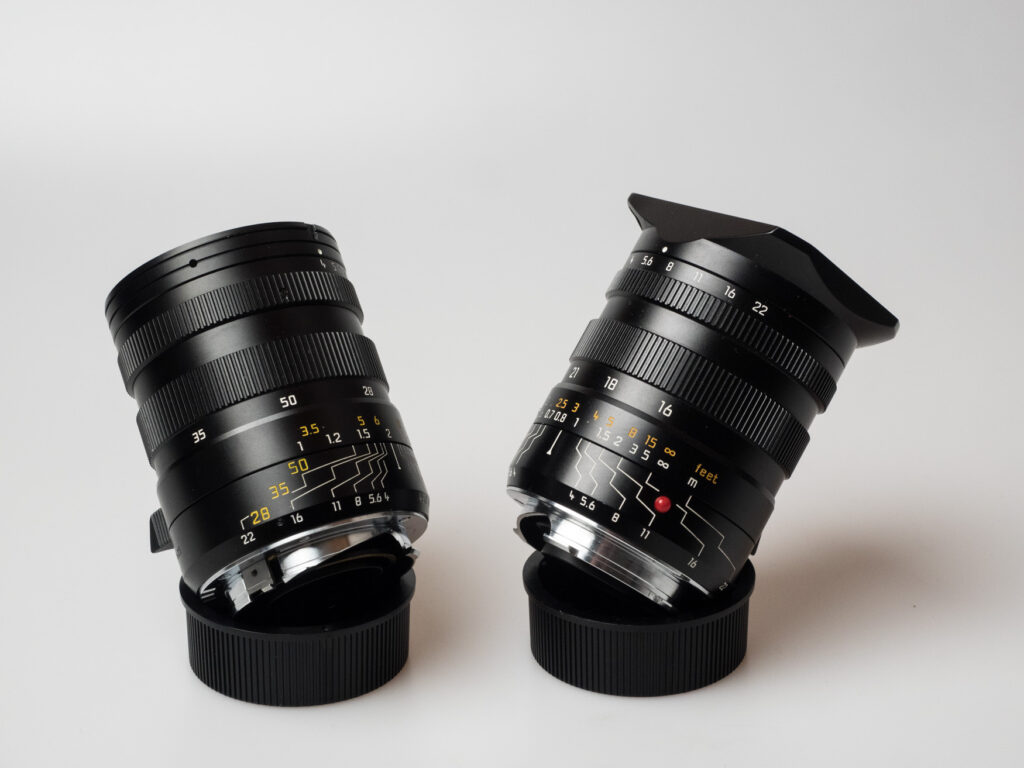
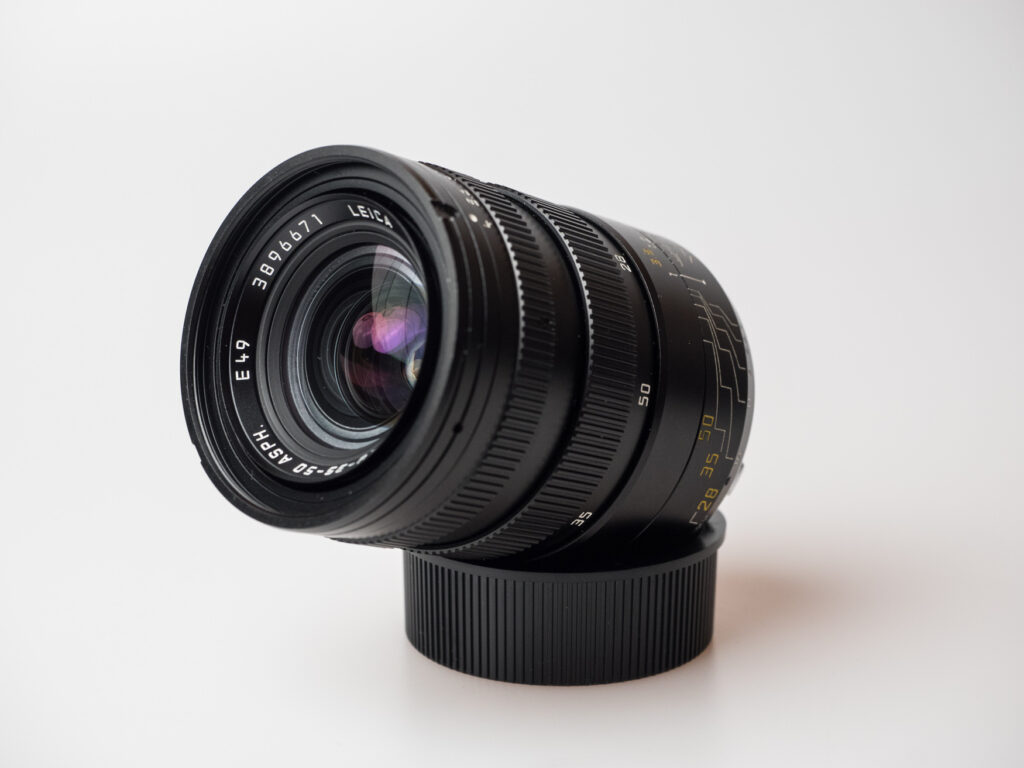
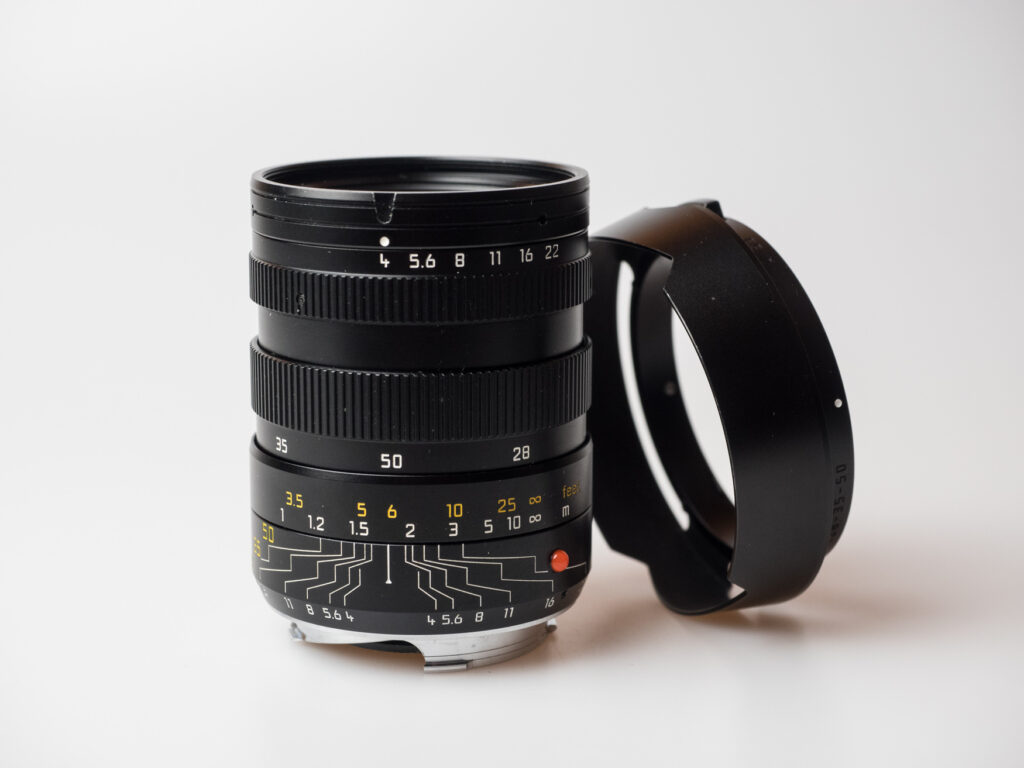
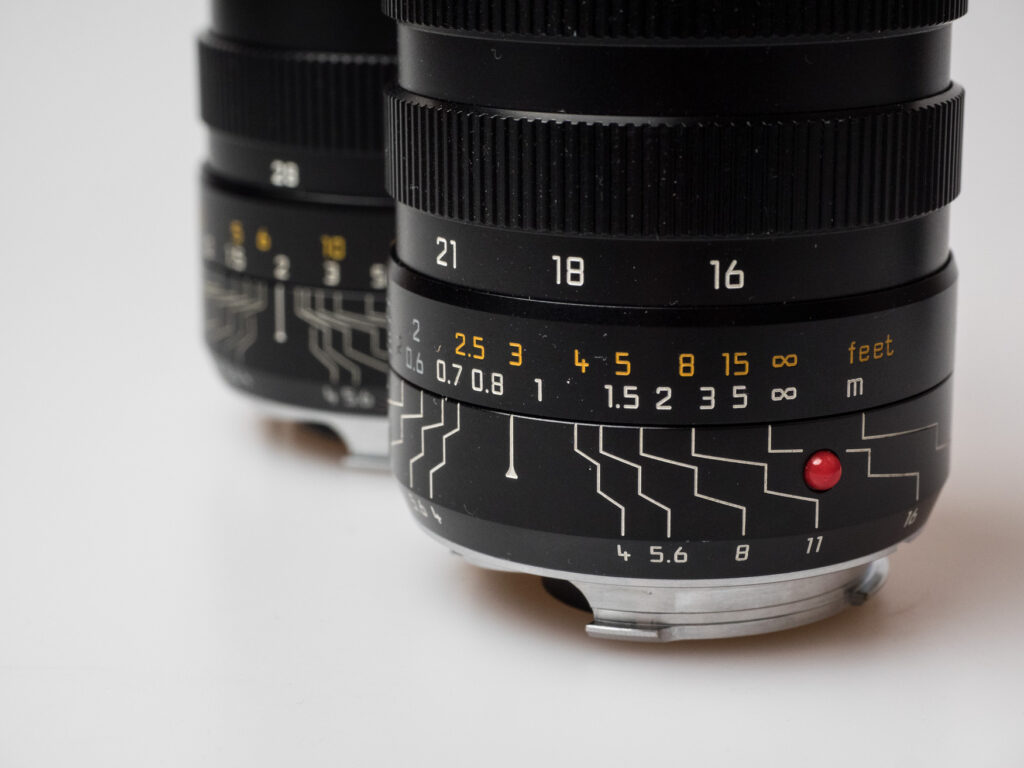
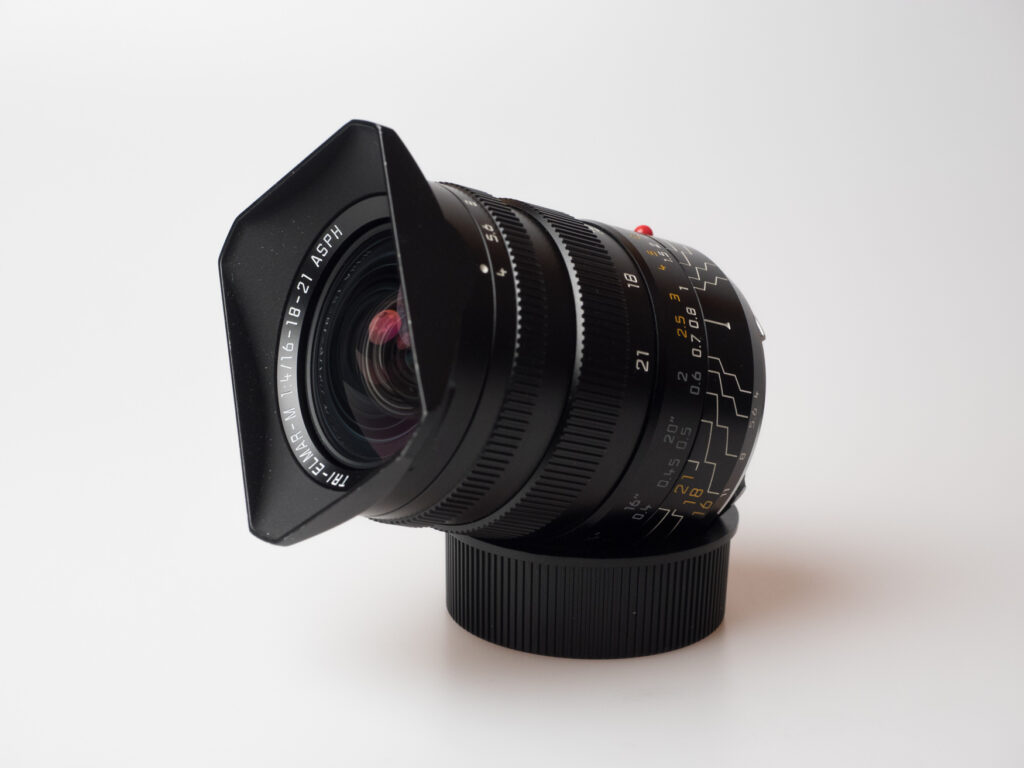
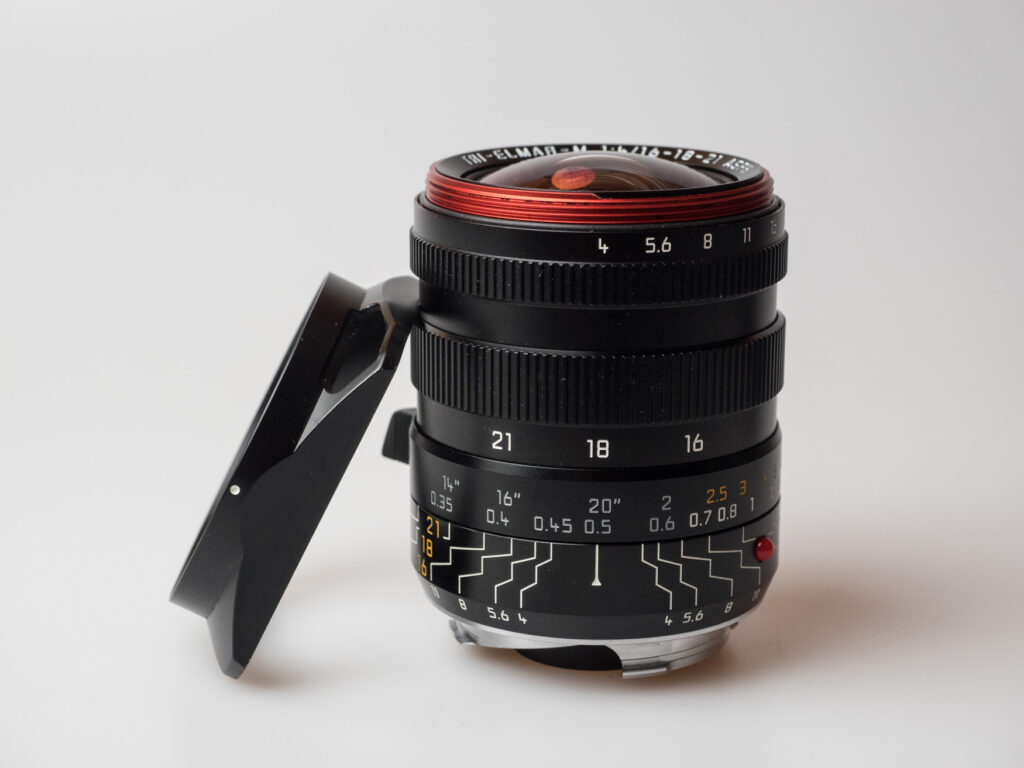
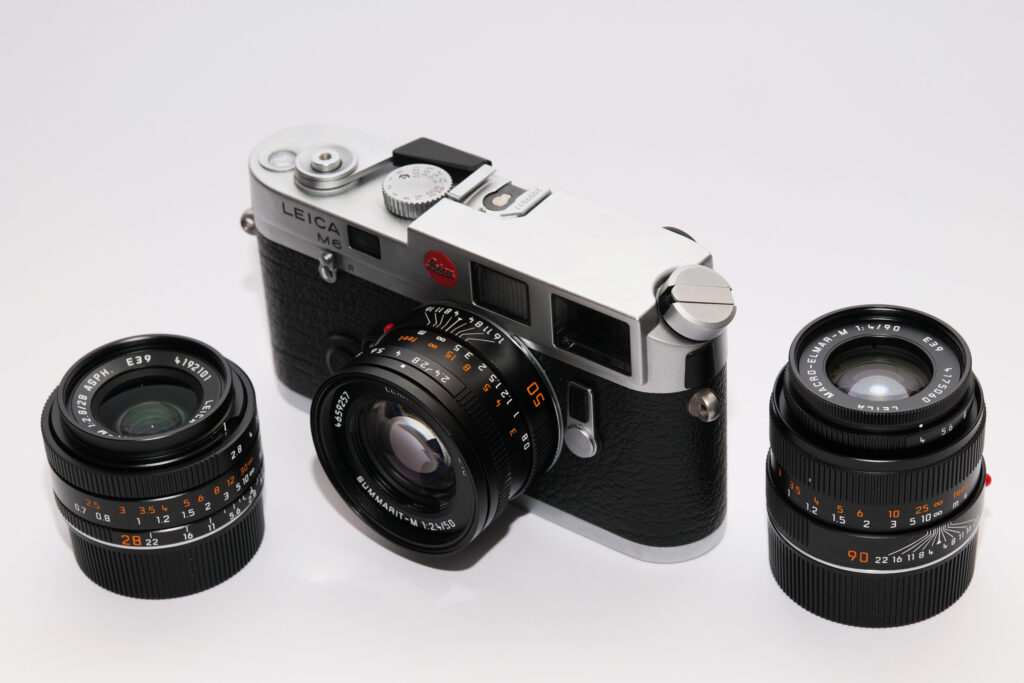
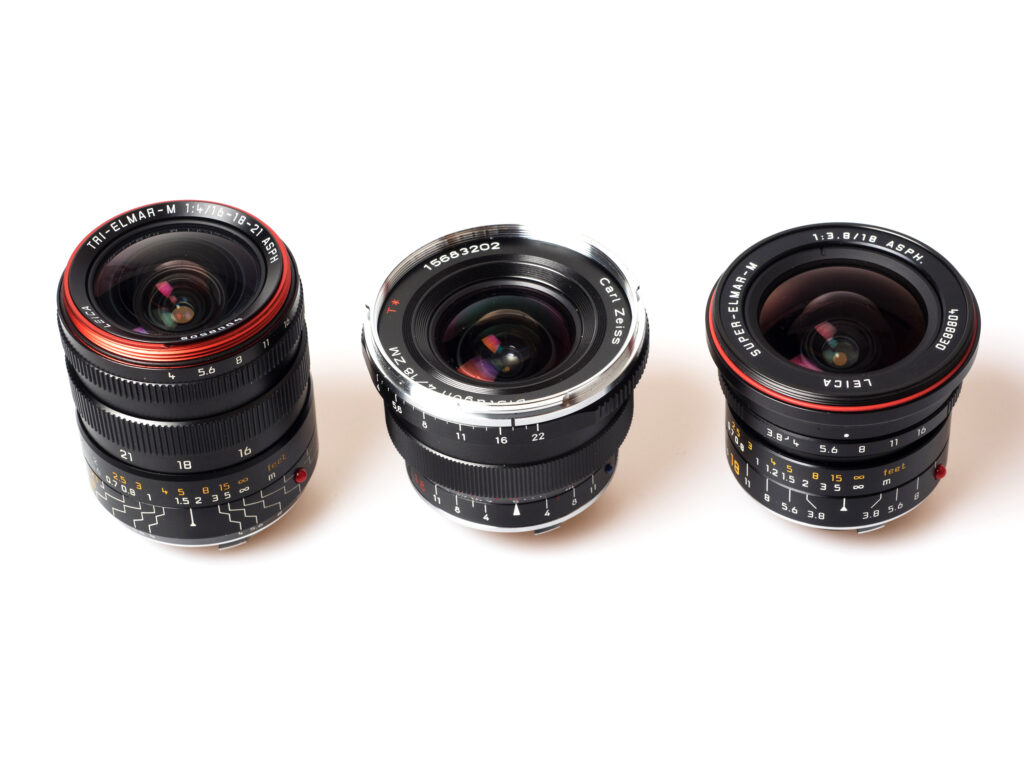

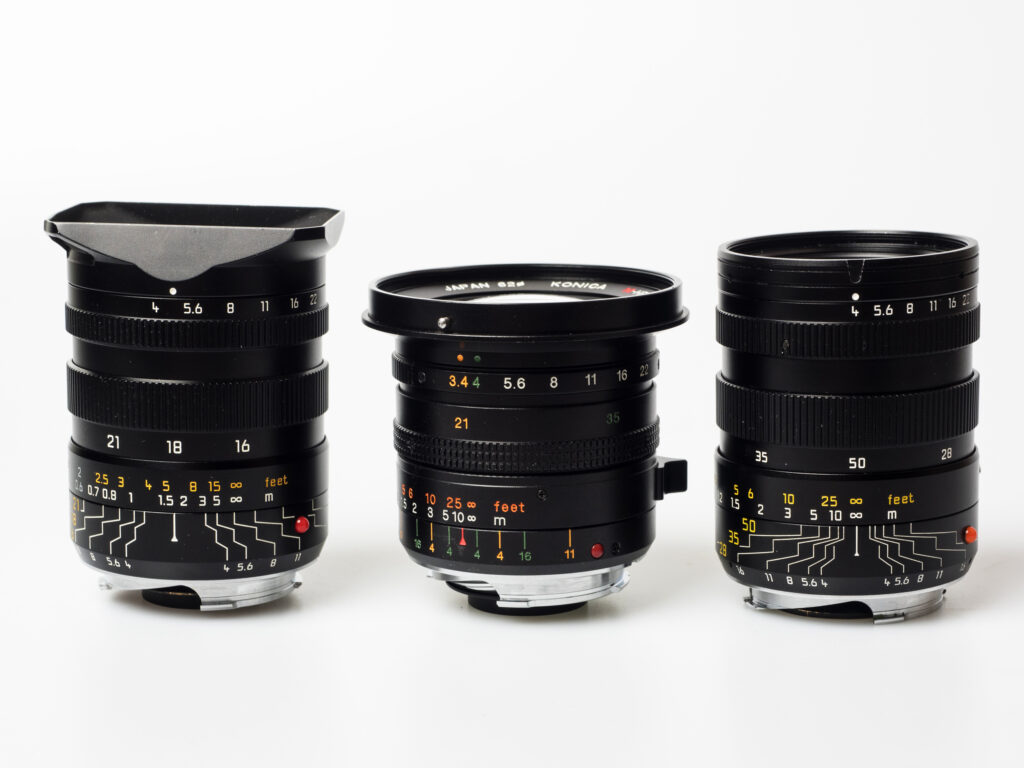
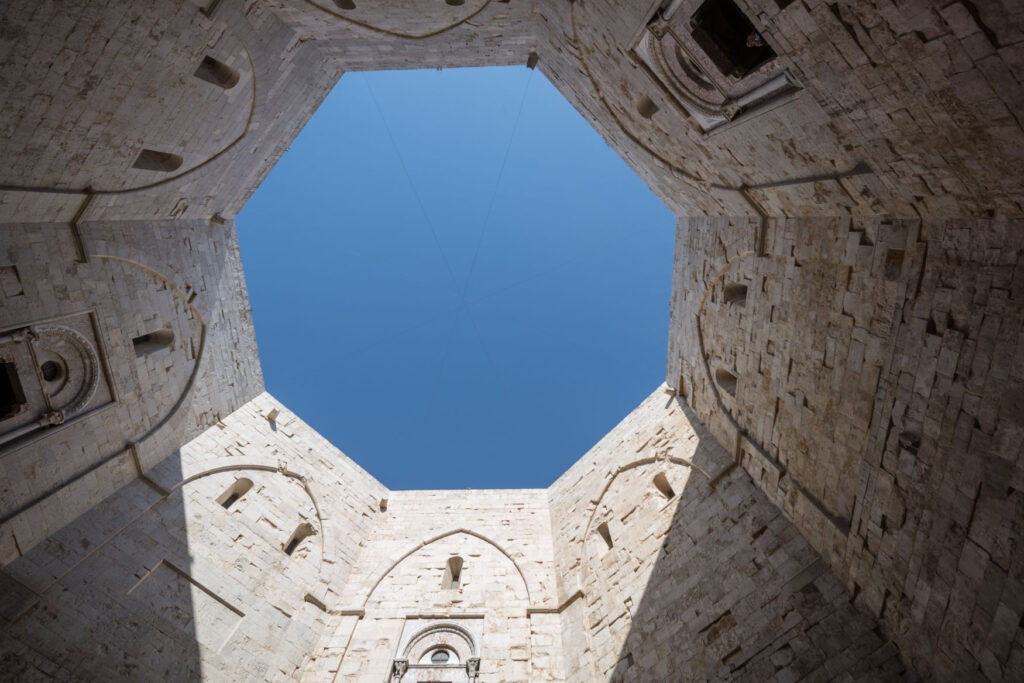






I used to use a MATE 28-35-50mm f/4 Tri-Elmar (2nd version) with a 90mm f/2 APO-Summicron-M ASPH on an M7 as my travel kit. They were lost in Santa Fe on a winter trip, and I never recovered them.
Aside from the 1m close-focus, f/4 max aperture and lens blocking the viewfinder limitations, the MATE pictures were gorgeous. I could shoot just about everything with it and the 90/2 APO-Summicron-M. I say just about because there were definitely situations where closer focusing would have been needed, or where I wanted to isolate with depth of field and couldn’t at f/4.
That’s why, especially in the age of the M10 series and M11, I’ve never replaced them. Instead, I use a couple or three primes on an M10 or M10-R for travel, usually 35mm, 50mm and 90mm, and maybe a WATE. On a 3 week driving trip to Grand Marais MI (UP), I used an M10-R with 1959 35mm f/2 RF Summicron, 1949 50mm f/2 Summitar and 1973 90mm f/2.8 Tele-Elmar-M. I chose those three vintage lenses for a classic look and their light weight. The pictures were very good, allowing me to tell a great story.
On trips to the ruins at Chaco Canyon I’ve used the WATE and Voigtländer 28mm f/2 Vintage Ultron ASPH on an M10 for daylight pictures. On the same trips, I was using an OM System OM-1 and Leica DG Summilux 9mm f/1.7 or Leica DG Summilux 12mm f/1.4 for Milky Way and light painting in the ruins at night.
Because Leica and Voigtlander primes are so light, small, and focus closer, I’ve felt no need for the MATE.
My first Leica was an M7 and 35mm Summicron. At the time the salesperson was trying to persuade me to buy the MATE. Leica had a bundle offer on the M7 and 35mm but I would pay full price for the MATE. I couldn’t afford both and opted for the 35mm. When I returned a few years later to take the plunge with the MATE I was gutted to find it discontinued. One of my regrets !
Agreeing with others: your article was very informative. Like most here, I’ve looked at WATE with lust in my eyes; after reading your article, I’m less besotted.
A thought here: has anyone looked at the Vario Elmar R 35-70 f4? It is a bit heavy, and again, requires Live View. But I’ve found the rendering to be very good! And good copies can be found circa US$1000.
I understand there’s an f2.8 version which is larger and heavier…
And about 10x as expensive as well… The f2.8 version is one of the R-lenses most sought after by videographers…
I had the MATE for ages on my M6. Travelled through Asia with it.
Sadly sold it when it seemed that Leica would never make a digital M.
I’m hunting for a good copy.
Oh, I understand you so well. Selling a Leica M lens is something one often regrets, Marcus. I bought the current Summicron 50 twice for example. I had a beautful silver copy and traded it in for a Summilux. Many years later I came across a good silver 50 Cron and couldn’t resist. It was not the same item of course, it cost much more that I had got for my first 50 Cron, but I have learned my lesson now. Never let an M lens go if not absolutely necessary. JP
And a little wave from the APS-C world after enjoying this article very much. I do love my X-Vario lens and the quality it produces, in spite of being “slow”. So I have no difficulty in imagining how I could find myself in a “go for it” position vis-a-vis the WATE and the MATE if I were into full frame. The “send” button keeps telling me I have already said this! Don’t know when…………..
That’s interesting, John (not the fact that your comment appears twice, but the mentioning of APS). The WATE was first sold for use mainly on the M8 on which the range was wider due to the 1.3 crop factor. And I think I read somewhere that the Vari-Focal M lens (28-75) was developed together with or based on the lens of the X Vario. I never used one but heard several times how beautifully it renders. I hope you can use it for many years to come! JP
And a little wave from the APS-C world after enjoying this article very much. I do love my X-Vario lens and the quality it produces, in spite of being “slow”. So I have no difficulty in imagining how I could find myself in a “go for it” position vis-a-vis the WATE and the MATE if I were into full frame.
Thank you for yet another very informative and interesting article Joerg-Peter. I was aware of the existence of the lenses but had not paid much attention to them – I am now much better informed! My solution to mounting a zoom lens on an M digital body is to use my 21-35mm Vario Elmar R f3.5-4, obviously with EVF. I had tended to use it as a walk-about solution when exploring National Trust properties and for some landscape and townscape outings. Nowadays for me the drawback is weight – at 596g with adaptor it can be somewhat shoulder-sagging, so it has been a while since I used it – time to stiffen my resolve and test it on my M11 – previous use was on M240 (and M10M).
The 21-35 sounds exciting and is certainly a super versatile lens for landscape and architecture. How does this R mount classic perform an the different generations of digital M bodies? If you do not need the intermediary focal lengths, the Konica 21-35 Dual lens might be a good alternative. I found its rendering very good when used on the M10. JP
Hi Joerg-Peter, thank you for this fascinating tour of these two very unusual lenses. I do not own an M-mount rangefinder and so my interest was solely driven by learning more about this world and the approaches taken to produce lenses covering a range of focal lengths. Even though, as you highlight, these lenses are marvels of design and engineering, I was left thinking that my Q2, with its 28mm f/1.7 summilux and 47 megapixel sensor would be able to cover many of the photographic challenges you illustrated. Its lens is much faster than either of those you described, and digital cropping would easily cover the 28-35-50 mm range of the MATE whilst still delivering high resolution images. While it could not cover the wider angles of the WATE, 28mm is nevertheless pretty handy for many interior and architectural subjects. As you note, the difference in field of view across the WATE range is quite modest. If I really need some wide angle action I would turn to my SL2 coupled with the superb Sigma 14-24 mm f/2.8 Art zoom, where the variation in focal length and field of view is meaningful. I really enjoyed the article, even though rangefinders are not my thing! Thanks for expanding my photographic horizons. Keith
Dear Keith, thanks for your feedback. I have not managed to reply to all the comments until now, but I am still amazed who many readers are interested in these rather exotic lenses. As for your question: The Q2 with its versatile angle of view, its excellent lens and its generous cropping headroom will do most of the things a MATE can do as well. I am personally no friend of cropping, and of course a 50mm lens will give you a different image than a 28 just because in many cases, you will choose a different perspective. Otherwiswe I fully agree. The range between 16 and 21 is quite small, so the 14-24 offers far more opportunities. I am looking forward to seeing new images from you! JP
Wonderful article and good to see the MATE and WATE getting some attention. I purchased my WATE prior to a Med Cruise in 2018. It is by far one of my most used lenses, especially for travel. With the Live View option on the M10, I have no need for the Frankenfinder. I wrote an article for the LHSA Viewfinder on this lens, calling it the ultimate travel lens.
I had a v2 MATE years ago, but foolishly sold it. I replaced it with a nice used one, another v2 a few years ago. I recently used it on my M10M while touring the Leica Factory in Portugal. I found the three focal lengths ideal for the situation, and the results on the M10M left nothing to be desired. I also didn’t want to be changing lenses in this situation, and the MATE fit the bill.
Regarding the near mythical Vario-Focal-M lens, I have personally seen at least three of them together in the Archive in Wetzlar. I will look through my files to see exactly how many they have, as I took a picture of them all together. This was during my tour in 2019.
Dear Bill,
thank you for your feedback which makes me a bit proud. Great to hear that you liked the article. And I’m sure you know how to make most of these interesting and useful lenses. The Vario-Focal M lens is near mythical for sure. If you have the image you are writing about, I would be most interested to see it. I do not think that the person who won the auction will share any images of the lens or taken with the lens – that’s always a pity with these hyped colletors’ items. A lens in a cabinet or a bank safe is always somewhat saddening to me.
Best wishes, JP
Hello JP, I looked in my images from my tour in November 2021, and I have an image of two of these lenses. Memory tells me there were at least one or two more of them in the same box in the Archive. I’d be more than happy to share it, please tell me how.
I am also asking the others who were with me if they have any more pictures of them.
Bill, I will pass on your LSA Editor address to Jörg-Peter. Mike
HI There Bill
I had a play with the ‘mythical’ Vario-Focal M about 12 years ago at Solms 28-35-50-75 but actually, like the WATE it was a genuine zoom.
I think the problem with it was the mechanics required to get the framelines to show properly – made it too expensive to make.
All the best
Jono
Hi Jono, lucky you. Must have been quite interesting. Your assumption that the mechanics were too expensive for mass production sounds perfectly sensible. Back then, Leica was not in the position to take very high risks nor to command such exorbitant prices as they sometimes are doing today. All the best, JP
Thank you for sharing your well-researched article on Leica Tri-Elmar lenses. I bought new, and still have, the MATE second or third version (not sure what is the difference; they both share the same part number and benefit from slight redesign of the body). My lens was coded by Leica later. Do you know the distinction beteen MATE V2 and V3?
Initially I used the MATE with my new M6 with a 0.58 viewfinder, specially designed for spectacle wearers. It is easier to see the 28 mm frame-lines. With modern zoom lenses, of excellent quality, there is little need for the MATE coupled with L-mount cameras, but I used it a lot on my Leica M8. I must give it another airing.
Hi David, as far as I know, the interior painting of the barrel was changed in version 3 in order to reduce flare. I further believe to have read somewhere that Leica altered the painting of the lens rims for the same reason but that this was also occanionally added for customers who sent their earlier MATEs to customer care. Another issue was a propensity to mechanical failure when switching between focal lengths. But I do not know if this was taken care of between version 1 and 2 oder between version 2 and 3. JP
I’m using a MATE, initially on the M10, now on the M10R, and couldn’t agree more with the quality it renders and its convenience. I sent mine to Leica NJ for a CLA and 6-bit conversion, which even though they sent it to Germany, was returned much sooner that I had expected with modest cost. The hood is scarce and relatively expensive, but not nearly as much as some Leica hoods. I print up to 13×19 at home, occasionally send out for a 16×20, and am not in any way disappointed with the results.
Glad to hear, Rick, that you also like the MATE. The size you are mentioning is impressive and another proof of the quality of this lens. But in my case, the photopgrapher is the limiting factor in most instances anyway… JP
I have had a WATE for about 12 years and I am sure that some photos I have taken with the lens have appeared on Macfilos. These days I generally prefer to use my 24mm Elmar, but I always have the WATE for back up. “Italian Flag’ used to be an issue using ultra wide angle lenses on digital Ms, but that seems to have disappeared, as I have not seen it for some years. Vignetting of all kinds can be fixed in seconds on Lightroom. Indeed, you can ‘vignette to taste’ these days with Lightroom.
The best thing about the WATE, though, is that it came with the Frankenfinder which I also use with the 24mm Elmar. This to me is many times better than any EVF I have used and it comes with a spirit level below the viewing screen for people who are worried about slanting horizons.
All that being said, OCOL (one lens, one camera) always has been the ruling philosophy for me with a Leica M. My typical kit is a 35mm Summicron and a 75mm Summarit and if I change (which is rare) from the 35mm to the 75mm at any stage in the day I usually just continue with that. Somedays I just decide to go out with a 50 Summilux and be done with that. If I am going to a place with buildings and interiors I will usually bring the 24mm. I have not used my WATE very much in recent years, but I am glad to still have it. For me, using a Leica is all about the single focal length experience, even though I have many different focal lengths in my collection and interchangeable lenses on Leicas actually go back as far as the late 1902s. I have told Mike that I will do an article on the very first interchangeable lens Leicas which were ‘done’ in Britain in the 1920s rather than in Germany where the first interchangeable lens Leicas were made in 1930.
William
Dear William,
thank you so much for your feedback. I guess it is always great to have a lens in the drawer just in case. The WATE is a stunning lens for sure, and indeed I saw no colour drift towards the margins with the M10. My former M Typ 262 was, with wide angle lenses attached, much more prone to this failure which is not so easy to correct. OCOL is a great strategy, and I find myself more and more often going out with just one camera and one lens. Would you say the MATE on a body still meets the standards of OCOL?
And if you use the 24, do you guesstimate the framing or are you using an attachable viewfinder? If always felt that if I do take the trouble to work clumsily with two windows to look through, I get more out of it with the 21mm focal length. So, I am more of a 21 or 28 type.
Anyway – I am curious to read from you soon! Best wishes, JP
Thank you William, for sharing your knowledge and experience here once more. Indeed, the newer digital M cameras show less propensity for colour drift, and maybe the WATE is particulary good in this respect. I found the M10 far better with super wide angle lenses than my former M (Typ 262) which, of course, also lacks live view making it less than ideal for focal lengths under 28. A propos: Do you use the 24 with an external viewfinder or can you handle it with the rangefinder? And, just out of curiosity: Is a M body and MATE setup valid for OCOL in your eyes :-)? – Looking forward to your next contribution! All the best, JP
Thanks JP. I use the 24mm with the Frankenfinder. It is actually a relatively compact package. I much prefer the frame-lines and optical VF to any EVF. For me, such as at a car show or inside a building, this is pretty critical as I reframe a lot before I take photos of objects with well defined corners and horizontal and vertical shapes. It is different for everyone, of course, but I can only speak to what suits me.
William
Thanks for all the interesting detail. Why not write a little article for Macfilos? You could then show us what you can do with the WATE? I’m always ready to help.
Mike
Very happy to do that Mike, I’ve been writing a few articles lately and am just finishing one off. I’ll put something together in due course and drop you a line.
Regards,
Röd
For a long time I actively searched for a mint condition, used WATE. One finally came up for sale about 3 years ago and it’s been one of my most treasured lenses ever since. I don’t use it all the time but I pretty much always have it with me. Being so small and light, it adds very little to an already light camera bag but what it offers is astounding. Mine came with the Frankenfinder which I didn’t want and left in the shop. A bit of a mistake there as I’ve just bought a new film camera.
Recently I used it extensively at Wells Cathedral and got some really nice internal and external shots. When I got there, I just knew straight away it would be perfect for most of the day. It didn’t disappoint and prompted my wife to buy a super-wide angle lens for her camera.
I also used it on the famous roof at Potsdamer Platz in Berlin and got my own take on this fabulous architecture with the sun shining through.
On Boxing Day a project I’ve been wanting to do for ages, unfolded by pure chance when I got diverted down the A1 driving back from Scotland. I’ve wanted to take pictures of the Angel of the North for ages but never sure when it would be possible, it’s a long way away. The weather was stunning, cold, sunny, blue sky, bright but low sun and it was really quiet there too being Boxing Day. I couldn’t have planned it better if I’d tried and the lens as always was in the bag.
It’s awesome for sunstars if that’s your thing and I’ve used that to great effect on artistic shots including one of the aforementioned Angel.
I’m very impressed, definitely a keep lens if ever there was one. Try one if you haven’t already, you’ll not be disappointed.
I can’t upload any photos here, but I’ve got some fabulous (I like them) examples of what you can get with the WATE lens.
Thanks, Röd,
for you feedback. I can imagine that the WATE delivered supebt quality at the spots where you used it. If you know how to handle it you can get great effects with a super wide lens.
Your mentioning of the Angel of the North and Wells Cathedral reminds of my first two journeys to England in the 1990s, they actually led me to Newcastle and to rural Sumerset and Dorset. The experience (country, culture, people, language) motivated me to study Engish at University, a subject that I did not particulary like at school. I never regetted it and without this I would not be an author at Macfilos now… all the more I would be happy to see some of your images here soon.
All the best, JP